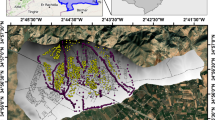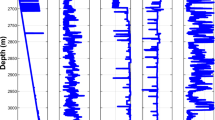Abstract
Landslide displacement prediction is an essential component for developing landslide early warning systems. In the Three Gorges Reservoir area (TGRA), landslides experience step-like deformations (i.e., periods of stability interrupted by abrupt accelerations) generally from April to September due to the influence of precipitation and reservoir scheduled level variations. With respect to many traditional machine learning techniques, two issues exist relative to displacement prediction, namely the random fluctuation of prediction results and inaccurate prediction when step-like deformations take place. In this study, a novel and original prediction method was proposed by combining the wavelet transform (WT) and particle swarm optimization-kernel extreme learning machine (PSO-KELM) methods, and by considering the landslide causal factors. A typical landslide with a step-like behavior, the Baishuihe landslide in TGRA, was taken as a case study. The cumulated total displacement was decomposed into trend displacement, periodic displacement (controlled by internal geological conditions and external triggering factors respectively), and noise. The displacement items were predicted separately by multi-factor PSO-KELM considering various causal factors, and the total displacement was obtained by summing them up. An accurate prediction was achieved by the proposed method, including the step-like deformation period. The performance of the proposed method was compared with that of the multi-factor extreme learning machine (ELM), support vector regression (SVR), backward propagation neural network (BPNN), and single-factor PSO-KELM. Results show that the PSO-KELM outperforms the other models, and the prediction accuracy can be improved by considering causal factors.

















Similar content being viewed by others
References
An H, Viet TT, Lee G, Kim Y, Kim M, Noh S, Noh J (2016) Development of time-variant landslide-prediction software considering three-dimensional subsurface unsaturated flow. Environ Model Softw 85:172–183
Barzegar R, Adamowski J, Moghaddam AA (2016) Application of wavelet-artificial intelligence hybrid models for water quality prediction: a case study in Aji-Chay River, Iran. Stoch Env Res Risk A 30(7):1797–1819
Bogaard T, Greco R (2018) Invited perspectives: hydrological perspectives on precipitation intensity-duration thresholds for landslide initiation: proposing hydro-meteorological thresholds. Nat Hazard Earth Sys 18(1):31–39
Cao Y, Yin K, Alexander DE, Zhou C (2016) Using an extreme learning machine to predict the displacement of step-like landslides in relation to controlling factors. Landslides 13(4):725–736
Cao Y, Yin K, Zhou C (2013) Comprehensive assessment on Sanzhouxi landslide stability considering displacement monitoring. Electr J Geol Eng 18:5507–5524
Carlà T, Intrieri E, Di Traglia F, Casagli N (2016) A statistical-based approach for establishing probabilistic warning thresholds of flank eruption occurrence using one-step ahead forecasts of displacement time series. Nat Hazards 84(1):669–683
Carlà T, Intrieri E, Farina P, Casagli N (2017) A new method to identify impending failure in rock slopes. Int J Rock Mech Min 93:76–81
Casagli N, Catani F, Del Ventisette C, Luzi G (2010) Monitoring, prediction, and early warning using ground-based radar interferometry. Landslides 7(3):291–301
Chen Q, Kou X, Huang S, Zhou Y (2004) The distributes and geologic environment characteristics of red beds in China. J Eng Geol 12(1):34–40
Conte E, Donato A, Troncone A (2017) A simplified method for predicting rainfall-induced mobility of active landslides. Landslides 14(1):35–45
Corominas J, Moya J, Ledesma A, Lloret A, Gili JA (2005) Prediction of ground displacements and velocities from groundwater level changes at the Vallcebre landslide (Eastern Pyrenees, Spain). Landslides 2(2):83–96
Crosta GB, Agliardi F (2012) How to obtain alert velocity thresholds for large rockslides. Physics and Chemistry of the Earth 27(36):41):1557–1565
Crozier MJ (1986) Landslides: causes, consequences & environment. Taylor & Francis
Daubechies I (1990) The wavelet transform, time-frequency localization and signal analysis. IEEE T Inform Theory 36(5):961–1005
Daubechies I (1992) Ten lectures on wavelets. Society for industrial and applied mathematics
Du J, Yin K, Lacasse S (2013) Displacement prediction in colluvial landslides, Three Gorges Reservoir, China. Landslides 10(2):203–218
Eberhart R, Kennedy J (1995) A new optimizer using particle swarm theory. In: Micro Machine and Human Science, 1995. MHS'95., Proceedings of the Sixth International Symposium on, pp. 39–43
Eid HT (2014) Stability charts for uniform slopes in soils with nonlinear failure envelopes. Eng Geol 168:38–45
Fukuzono T (1985) A new method for predicting the failure time of a slope. Proceedings of the 4th International Conference and Field Workshop in Landslides Tokyo
Glade T, Anderson M, Crozier MJ (2005) Landslide hazard and risk: issues, concepts and approach. In: Landslide hazard and risk. Wiley, pp 1–40
Haar A (1910) Zur theorie der orthogonalen funktionensysteme. Math Ann 69(3):331–371
Huang F, Huang J, Jiang S, Zhou C (2017) Landslide displacement prediction based on multivariate chaotic model and extreme learning machine. Eng Geol 218:173–186
Huang G, Zhou H, Ding X, Zhang R (2012) Extreme learning machine for regression and multiclass classification. IEEE Transactions on Systems Man and Cybernetics Part B (Cybernetics) 42(2):513–529
Huang G, Zhu Q, Siew C (2004) Extreme learning machine: a new learning scheme of feedforward neural networks. In: Neural networks 2004 proceedings pp: 985–990
Huang G, Zhu Q, Siew C (2006) Extreme learning machine: theory and applications. Neurocomputing 70(1):489–501
Intrieri E, Gigli G (2016) Landslide forecasting and factors influencing predictability. Nat Hazards Earth Syst Sci 16(12):2501–2510
Intrieri E, Gigli G, Casagli N, Nadim F (2013) Brief communication: landslide early warning system: toolbox and general concepts. Nat Hazards Earth Syst Sci 13:85–90
Keefer DK, Wilson RC, Mark RK, Brabb EE, Brown WM III, Ellen SD, Harp EL, Wieczorek GF, Alger CS, Zatkin RS (1987) Real-time landslide warning during heavy rainfall. Science 238(4829):921–926
Krkač M, Špoljarić D, Bernat S, Arbanas SM (2017) Method for prediction of landslide movements based on random forests. Landslides 14(3):947–960
Li D, Yin K, Leo C (2010) Analysis of Baishuihe landslide influenced by the effects of reservoir water and rainfall. Environ Earth Sci 60(4):677–687
Lian C, Zeng Z, Yao W, Tang H (2014) Extreme learning machine for the displacement prediction of landslide under rainfall and reservoir level. Stoch Env Res Risk A 28:1957–1972
Lima AR, Cannon AJ, Hsieh WW (2015) Nonlinear regression in environmental sciences using extreme learning machines: a comparative evaluation. Environ Model Softw 73:175–188
Liu Y, Liu D, Qin Z, Liu F, Liu L (2016) Rainfall data feature extraction and its verification in displacement prediction of Baishuihe landslide in China. B Eng Geol Environ 75(3):897–907
Ma J, Tang H, Liu X, Hu X, Sun M, Song Y (2017) Establishment of a deformation forecasting model for a step-like landslide based on decision tree C5.0 and two-step cluster algorithms: a case study in the Three Gorges Reservoir area, China. Landslides 14(3):1275–12281
Mallat SG (1989) A theory for multi-resolution signal decomposition: the wavelet representation. IEEE T Pattern Anal 11(7):674–693
Mazzanti P, Bozzano F, Cipriani I, Prestininzi A (2015) New insights into the temporal prediction of landslides by a terrestrial SAR interferometry monitoring case study. Landslides 12(1):55–68
Meyer Y (1990) Ondelettes et opérateurs. Hermann, Paris
Miao H, Wang G, Yin K, Kamai T, Li Y (2014) Mechanism of the slow-moving landslides in Jurassic red-strata in the Three Gorges Reservoir, China. Eng Geol 171:59–69
Miao F, Wu Y, Xie Y, Li Y (2018) Prediction of landslide displacement with step-like behavior based on multialgorithm optimization and a support vector regression model. Landslides 15(3):475–488
Mufundirwa A, Fujii Y, Kodama J (2010) A new practical method for prediction of geomechanical failure-time. Int J Rock Mech Min 47(7):1079–1090
Petley D (2012) Global patterns of loss of life from landslides. Geology 40(10):927–930
Ren F, Wu X, Zhang K, Niu R (2015) Application of wavelet analysis and a particle swarm-optimized support vector machine to predict the displacement of the Shuping landslide in the Three Gorges, China. Environ Earth Sci 73(8):4791–4804
Saito M (1965) Forecasting the time of occurrence of a slope failure. In: Proceedings of the 6th international conference on soil mechanics and foundation engineering pp: 537–541
Saito M (1969) Forecasting time of slope failure by tertiary creep. In: Proceedings of 7th international conference on soil mechanics and foundation engineering pp: 677–683
Sassa K, Picarelli L, Yin Y (2009) Monitoring, prediction and early warning. In: Landslides-disaster risk reduction. Springer Berlin Heidelberg, pp 351–375
Sun G, Yang Y, Jiang W, Zheng H (2017) Effects of an increase in reservoir drawdown rate on bank slope stability: a case study at the Three Gorges Reservoir, China. Eng Geol 221:61–69
Tang H, Li C, Hu X, Wang L, Criss R, Su A, Wu Y, Xiong C (2015) Deformation response of the Huangtupo landslide to rainfall and the changing levels of the Three Gorges Reservoir. B Eng Geol Environ 74(3):933–942
Vasu NN, Lee S (2016) A hybrid feature selection algorithm integrating an extreme learning machine for landslide susceptibility modeling of Mt. Woomyeon, South Korea. Geomorphology 263:50–70
Wu X, Benjamin Zhan F, Zhang K, Deng Q (2016) Application of a two-step cluster analysis and the Apriori algorithm to classify the deformation states of two typical colluvial landslides in the Three Gorges, China. Environ Earth Sci 75(2):146–161
Yabe H, Hayasaka I (1920) Geographical research in China, 1911–1916: reports. Paleontology of Southern China. Tokyo Geographical Society, Tokyo
Yang Z, Ce L, Lian L (2017) Electricity price forecasting by a hybrid model, combining wavelet transform, ARMA and kernel-based extreme learning machine methods. Appl Energ 190:291–305
Zhou C, Yin K (2014) Landslide displacement prediction of WA-SVM coupling model based on chaotic sequence. Electr J Geol Eng 19:2973–2987
Zhou C, Yin K, Cao Y, Ahmed B (2016) Application of time series analysis and PSO-SVM model in predicting the Bazimen landslide in the Three Gorges Reservoir, China. Eng Geol 204:108–120
Zhou C, Yin K, Cao Y, Ahmed B, Li Y, Catani F, Pourghasemie HR (2018) Landslide susceptibility modeling applying machine learning methods: a case study from Longju in the Three Gorges Reservoir area, China. Comput Geosci 112:23–27
Zhu X, Xu Q, Tang M, Nie W, Ma S, Xu Z (2017) Comparison of two optimized machine learning models for predicting displacement of rainfall-induced landslide: a case study in Sichuan Province, China. Eng Geol 218:213–222
Acknowledgements
The comments from the anonymous reviewers and the editors have significantly improved the quality of this article. The first author would like to thank the China Scholarship Council for funding his research at the University of Florence, Italy.
Funding
This paper was prepared as part of the projects “The study of mechanism and forecast criterion of the gentle-dip landslides in The Three Gorges Reservoir Region, China” (no. 41572292) and “Study on the hydraulic properties and the rainfall infiltration law of the ground surface deformation fissure of colluvial landslides” (no. 41702330) funded by the National Natural Science Foundation of China.
Author information
Authors and Affiliations
Corresponding author
Rights and permissions
About this article
Cite this article
Zhou, C., Yin, K., Cao, Y. et al. Displacement prediction of step-like landslide by applying a novel kernel extreme learning machine method. Landslides 15, 2211–2225 (2018). https://doi.org/10.1007/s10346-018-1022-0
Received:
Accepted:
Published:
Issue Date:
DOI: https://doi.org/10.1007/s10346-018-1022-0




